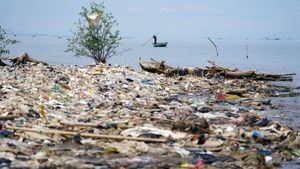The ocean is often referred to as the final frontier, with vast, unexplored depths hiding complex ecosystems and undiscovered wonders. A recent discovery made by the Pristine Seas team has brought forth evidence supporting this notion, as they unveiled the world’s largest coral colony off the coast of the Solomon Islands. This monumental find has not only captivated the scientific community but also sparked curiosity about the mysteries still lurking beneath the waves.
While observing the waters surrounding these islands—situated near Papua New Guinea—researchers initially mistook the colossal underwater formation for a shipwreck. Upon closer inspection, they were astonished to find what would be revealed as the largest “mega coral” known to science. This coral colony, measuring approximately 112 feet by 105 feet and rising 16 feet high, is comparable to the body length of blue whales and is estimated to be around 300 years old.
The coral, identified as Pavona clavus, is characterized by its expansive size and unique flat structure, which contrasts with the more traditional, towering formations of coral reefs. This discovery challenges conventional understandings of coral ecosystems, as most reefs consist of multiple species, yet this mega coral is predominantly one species, Pavona clavus. Its tan and yellow coloration, reminiscent of the human clavicle’s shape, marks it as both fascinating and formidable.
Corals like Pavona clavus are unique creatures. They function as both individual organisms and communal entities, with billions of polyps co-existing and communicating through chemical signals to thrive. This interconnectedness allows them to act as one giant organism, making the discovery all the more astonishing.
Despite facing threats from pollution, climate change, and other human activities, this massive coral colony has thrived where many others have perished. National Geographic notes the location’s cool sea temperatures, gentle slopes, and protected shelter as beneficial to its growth and survival. It stands as hopeful evidence for marine life adaptation, especially as global coral reefs confront alarming rates of bleaching and decline.
The island community surrounding this extraordinary site has expressed immense excitement about the discovery, viewing it as a potential boon for local conservation efforts. Throughout the exploration, which prioritized documenting the region's biodiversity, filmmakers and cinematographers were also present to capture footage highlighting the significance of the reefs. Their mission not only serves to reveal the charismatic marine wildlife but to gather compelling evidence for increased protection of these eligible areas.
This surprising find arrived during dire circumstances for coral reefs worldwide. Experts report unprecedented levels of bleaching, largely attributed to climate-induced temperature changes. Over the last few years, it has become increasingly common for corals to struggle due to rising ocean temperatures. While coral reefs had existed for millions of years, their current threats may render significant portions of healthy reefs extinct within the coming decades.
The alarming rates of bleaching can be illustrated through recent statistics: between 2023 and 2024 alone, the effects of global warming on coral brought about conditions equivalent to two decades’ worth of heat accumulation within just one year. The rising temperatures and ocean acidification unfortunately lead to stress and algae loss, resulting in the coral turning from their vibrant hues to sun-bleached skeletons. Although some corals can recover, their survival hinges on receiving adequate conditions for algae to return, which is becoming increasingly rare.
Scientists stress the necessity for urgent action, warning of ramifications extending well beyond corals themselves. Coral reefs are not just aesthetic wonders; they are critically important habitats for countless marine species, offer storm protection for coastal communities, and sustain fishing economies. Commonsense conservation efforts alongside the need for utter changes to combat climate change are pivotal moving forward.
To safeguard the existence of coral reefs and their expansive ecosystems, science suggests embracing both local and global initiatives to reduce pollution and overfishing. Additional strategies point to promoting and nurturing coral grown within nurseries and supporting technological advancements aimed at disease prevention. Through innovative science, the potential to freeze and store coral species may pave the way for regenerative practices.
While the discovery of the vast Pavona clavus colony offers hope, it simultaneously serves as a reminder of the fragility existing within marine ecosystems. Not only is it imperative to celebrate such remarkable findings, but it also raises questions about how we can collectively work toward ensuring protection and sustainability for future generations. With steps taken today, it is possible to envision not only salvaging the once-abundant coral reefs but promoting resilience by mitigating the effects of climate change.
This colossal coral colony off the Solomon Islands undoubtedly opens up new avenues for exploration, funding, and conservation efforts aimed at preserving its enchanting beauty and ecological contributions.



